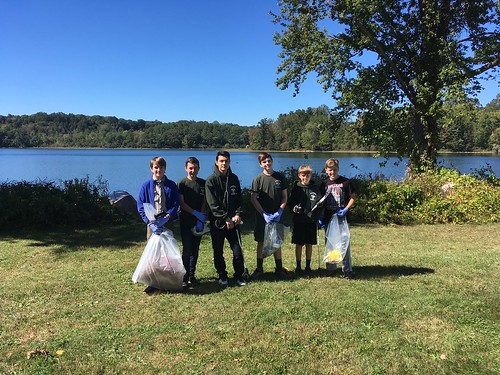FOR IMMEDIATE RELEASE 17-90 Record Number of Volunteers Participate in NYC DEP Reservoir Cleanup DayA total of 418 volunteers removed more than 2 tons of debris from reservoir shorelinesHigh-resolution photos from the event are available on DEP’s Flickr PageThe New York City Department of Environmental Protection (DEP) today announced that 418 volunteers from across the Catskill and Hudson Valley collected more than two tons of trash and recyclables during this year’s Reservoir Cleanup Day, making it the largest cleanup event since DEP began hosting them four years ago. The effort to remove debris, litter and recyclables from the shorelines at eight reservoirs was led by school groups, environmental advocates, business leaders, local nonprofits and watershed citizens. The Oct. 1 event comprised cleanup efforts at eight water supply reservoirs, including Ashokan, Cannonsville, and Pepacton reservoirs in the Catskill Mountains, and at East Branch, Kensico, Lake Gleneida, Muscoot and New Croton reservoirs in the Hudson Valley. In total, volunteers collected more than 300 bags of debris and recyclables. The haul weighed a total of more than 4,500 pounds. The results were a significant increase from last year’s cleanup, at which 264 volunteers retrieved more than 3,300 pounds of debris. In many cases, debris collected at the sites had blown onto the reservoir property from nearby roadsides, had washed up along the shores from past storms, or was left behind at access areas used by the public for fishing and boating. “I want to thank the volunteers who participated in Reservoir Cleanup Day for their benevolence, their hard work, and their commitment to protecting our shared natural resources,” DEP Commissioner Vincent Sapienza said. “The results from our cleanup event are impressive, but they also underscore the need for greater education. Too many people are still carelessly disposing their garbage. DEP is committed to teaching more people about outdoor ethics and the principles of leaving no trace when recreating on our lands and waters.” Debris collected during the cleanup included 4,948 plastic, glass and metal beverage containers, 1,196 cigarette butts, 952 food wrappers, 707 bottle caps, 485 plastic grocery bags, 792 cups and plates, 522 take-out containers, 278 yards of fishing line, 42 balloons, 26 tires, and 2,271 shards of foam, glass or plastic. Reservoir Cleanup Day was among dozens of similar events happening across the state as part of the American Littoral Society’s annual New York State Beach Cleanup, which organizes volunteers to remove debris from beaches, lake shores and stream banks. Data from the reservoir cleanups was reported back to the American Littoral Society to generate a statewide tally that will soon be available. DEP is among the government agencies, businesses and foundations that sponsor the statewide effort. In 2016, the New York State Beach Cleanup included 6,645 volunteers across who removed 66,830 pounds of debris along 233 miles of shoreline. DEP manages New York City’s water supply, providing more than 1 billion gallons of high-quality water each day to more than 9.5 million New Yorkers. This includes more than 70 upstate communities and institutions in Ulster, Orange, Putnam and Westchester counties who consume an average of 110 million total gallons of drinking water daily from New York City’s water supply system. This water comes from the Catskill, Delaware, and Croton watersheds that extend more than 125 miles from the City, and the system comprises 19 reservoirs, three controlled lakes, and numerous tunnels and aqueducts. DEP has nearly 6,000 employees, including almost 1,000 scientists, engineers, surveyors, watershed maintainers and other professionals in the watershed. In addition to its $70 million payroll and $166 million in annual taxes paid in upstate counties, DEP has invested more than $1.7 billion in watershed protection programs—including partnership organizations such as the Catskill Watershed Corporation and the Watershed Agricultural Council—that support sustainable farming practices, environmentally sensitive economic development, and local economic opportunity. In addition, DEP has a robust capital program with $20.7 billion in investments planned over the next 10 years that will create up to 3,000 construction-related jobs per year. For more information, visit nyc.gov/dep, like us on Facebook, or follow us on Twitter. | ||
